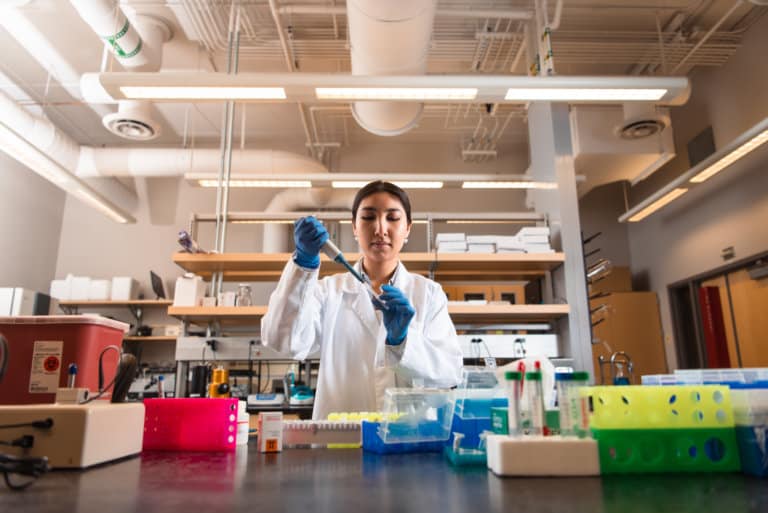
Medicine, robotics, manufacturing, social science, public health, engineering, computer sciences are disciplines that share a common thread — the need for skilled researchers.
To become a critical, competitive researcher in any field, you should obtain a graduate degree from a globally-recognised university. In the US, universities with R1 status are institutions of higher education well known for their prolific research activity. According to the Carnegie Foundation for the Advancement of Higher Education, there are approximately 146 US institutions that have R1 status. These universities are at the forefront of research and innovation, and they receive federal or private funding specifically for their academic research.
Research universities develop antibiotics, radio technology, search engine algorithms, surveying methods, and even barcodes. These institutions invest in new technologies and innovate in diverse fields. As drivers of discovery, research universities play a major role in the economy.
In addition to boasting an excellent track record in research, these universities also stand out for their teaching. As a result, students greatly benefit from attending research universities. Here are three top R1 universities that are worth considering:

Fargo has a family-friendly environment with a low cost of living, which is about $10,300 per year. Source: North Dakota State University
North Dakota State University
At North Dakota State University (NDSU), an R1 student-focused research university, students can explore and innovate across 80 diverse graduate programmes. Whichever programme they join, they’ll have the support of an expert faculty which has received US$175 million in annual research expenditures. With a low faculty-student ratio, graduate students can work closely with faculty members in an environment ripe for groundbreaking research and interdisciplinary collaborations.
And they get to do all of this while living in Fargo, North Dakota. NDSU boasts a picturesque setting that blends rural charm with urban vibrancy. Fargo, with a metro population of approximately 250,000, is safe, welcoming, and dynamic. Here, you’ll find a bustling entrepreneurial atmosphere, local culinary delights, vibrant arts and entertainment, and a family-friendly community where the yearly cost of living is just US$10,300. WalletHub named Fargo the third happiest city in America in 2021.
What further sets NDSU apart is its heritage as a land-grant institution. This makes its engineering and agriculture programmes especially strong. Faculty members in these programmes enjoy international recognition and secure prestigious grants, providing graduate students with numerous research opportunities. Importantly, NDSU extends funding support not only to engineering and agriculture programmes but also to humanities and social sciences as well as interdisciplinary programmes, ensuring that all students receive a world-class education.
Click here to learn more about North Dakota State University.

UC Berkeley is consistently ranked among the four top research universities in the world. Source: UC Berkeley Facebook
University of California, Berkeley (UC Berkeley)
UC Berkeley needs no introduction for its academic and research excellence. Named the number one public university worldwide by US News and World Report, UC Berkeley has been at the forefront of research throughout its history.
Here, students address the biggest challenges of the day to create a better world. From robotic legs to the origins of the universe, research at Berkeley crosses disciplines and illuminates new ideas. They do that by working side-by-side with Nobel Laureates, Fields medal winners, Fulbright Scholars and MacArthur fellows. The Graduate Division at UC Berkeley also provides funding to its graduate students through fellowships and travel grants.
Research at Berkeley takes place in academic departments, research centres, museums, and field stations. Academic departments offer courses and degrees, while research centres focus on broad topics and involve faculty and students from various disciplines. The best part? UC Berkeley has over 100 such research units. Meanwhile, museums contribute to research in fields like anthropology and palaeontology. Field stations are mainly in California’s remote areas – they support ecosystem, botany, zoology, and forestry studies.
Recently, five UC Berkeley-led projects received a total of US$13.9 million in grants to advance research that build climate resilience and equity in California, including mitigating wildfire risk, ensuring the equitable distribution of water and improving K-12 climate justice education.
“As the state’s preeminent research institution, the University of California is proud to partner with the state to pursue our shared climate goals. The innovations catalysed by the Climate Action awards will make all of our communities safer, more sustainable, and more resilient,” said UC President Michael V. Drake, M.D.

Johns Hopkins University in Baltimore, Maryland, is considered the first research university in the US. Source: Johns Hopkins University Facebook
Johns Hopkins University
Established as the first research university in the US, Johns Hopkins University has built an international reputation on its curriculum, which emphasises research and innovation, preparing students to develop big ideas and accomplish their professional goals. Flexibility, hands-on learning and mentorship are some of the elements that are emphasised in a JHU education.
For more than 140 years, its faculty and students have worked together in pursuit of discoveries that improve lives. Notable achievements include: water purification, launch of genetic engineering, invention of saccharine, CPR, and the supersonic ramjet engine. There are a total of 29 Nobel Prize winners associated with the university.
Whether you’re studying engineering, chemistry, music, anthropology, or any other subject, every student here — no matter his or her major — is an investigator. Just ask Yadam, a graduate from Class of 2016. “You can find research in whatever field you want because everyone here is doing some sort of research, and you can help out,” Yadam says.
Take Johns Hopkins Bloomberg School of Public Health, for example. Here, students are mentored, trained by renowned faculty and participate in research teams. With over 80 research centres and institutes available for internships and hands-on experiences, students can get a head start in producing groundbreaking work to improve health in their communities.
*Some of the institutions featured in this article are commercial partners of Study International









